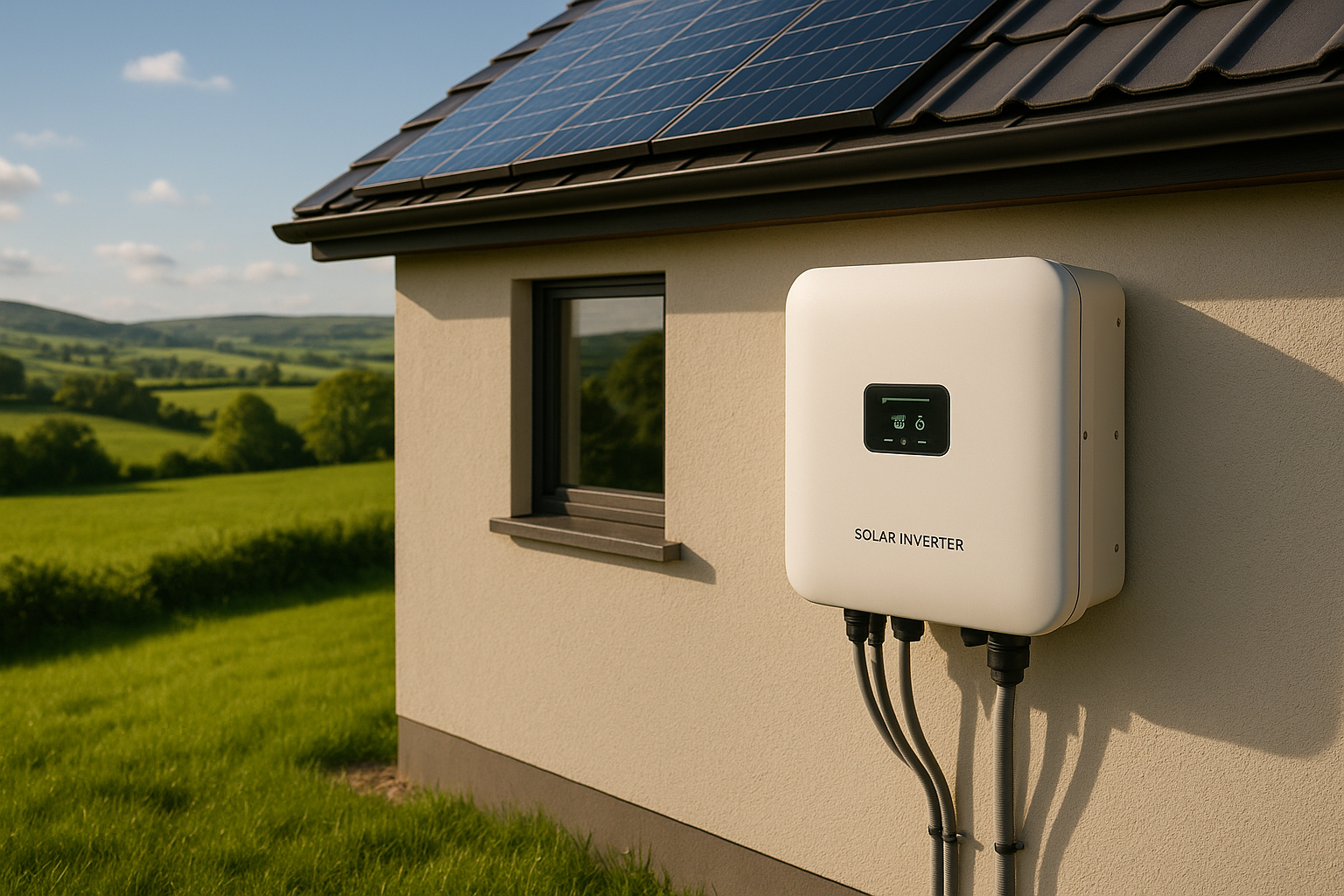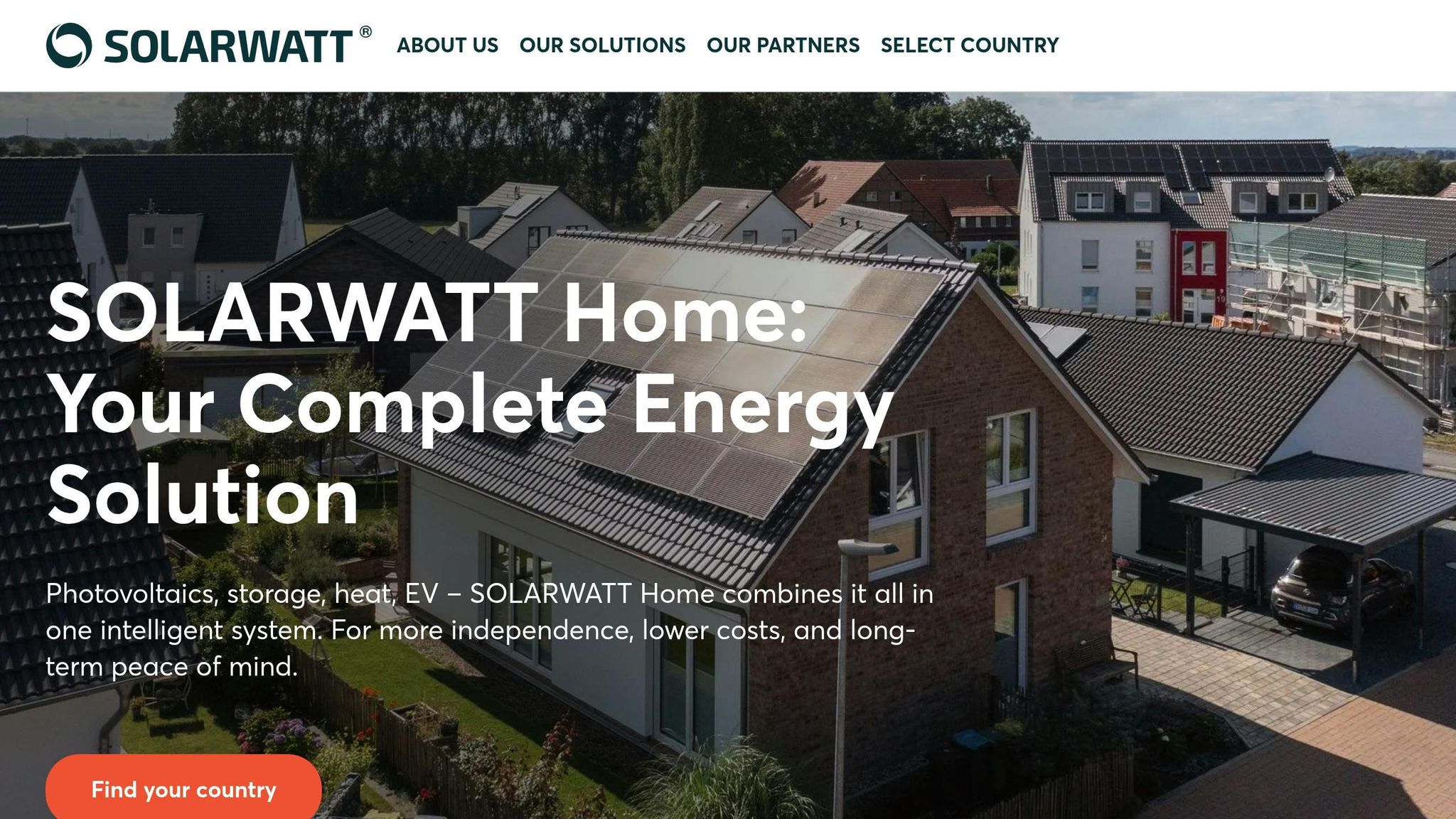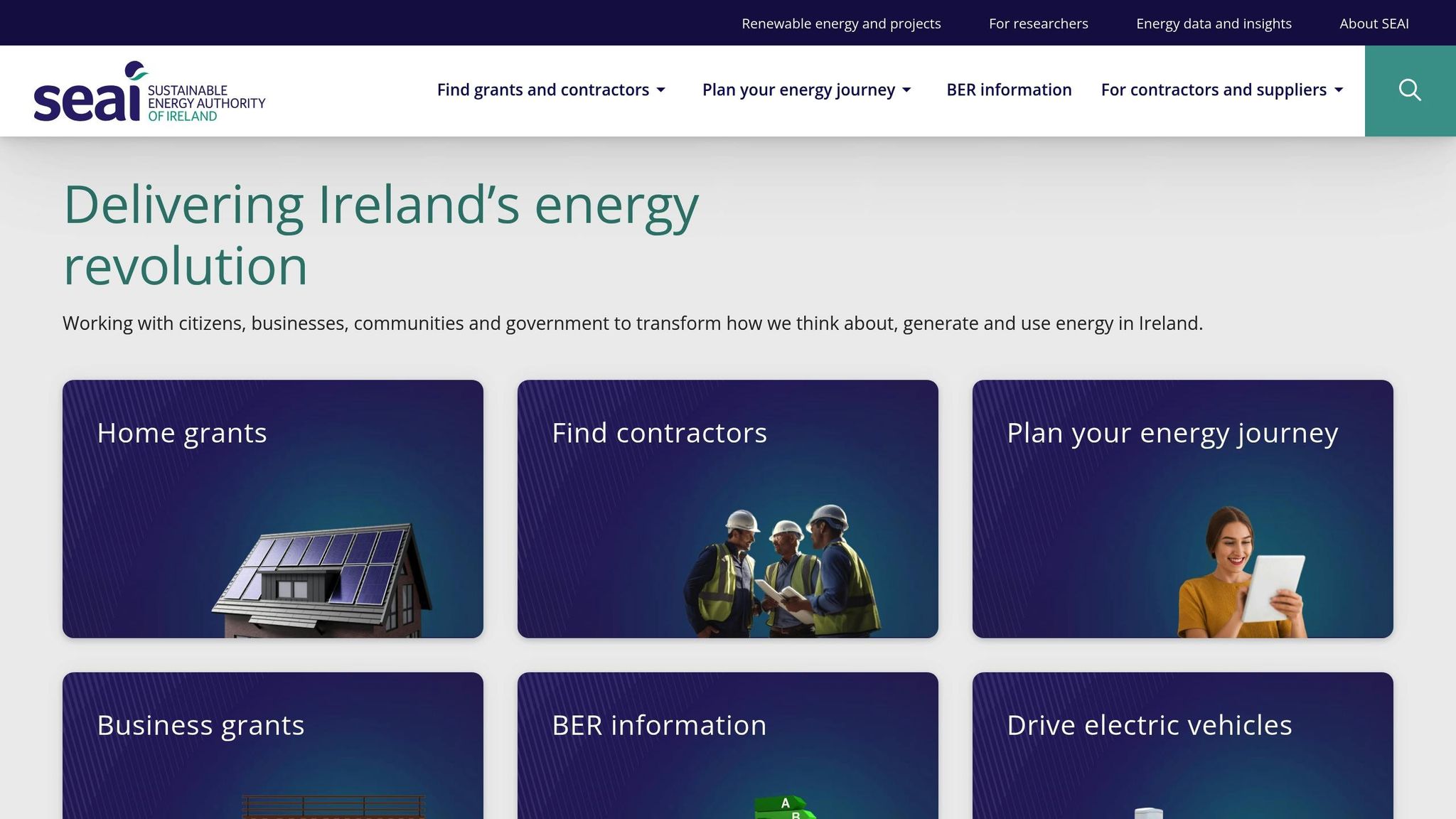Ultimate Guide to Solar Inverter Installation in Ireland
Learn how to install a solar inverter in Ireland, covering regulations, types, installation steps, and maintenance for optimal performance.

Installing a solar inverter in Ireland requires careful planning, compliance with regulations, and choosing the right equipment for your needs. Here's a quick rundown of what you need to know:
- What It Does: A solar inverter converts DC electricity from solar panels into AC electricity for home use and grid compatibility.
- Why It Matters: Ensures your system meets Irish grid standards, lowers electricity bills, and allows you to sell excess energy back to the grid.
- Regulations: Follow ESB Networks' grid connection rules and SEAI certification standards to qualify for grants.
- Choosing an Inverter: Options include string, hybrid, and battery-ready inverters. Consider efficiency, monitoring features, warranty, and future expansion needs.
- Installation Steps: Includes pre-installation planning, wiring, safety checks, and grid connection approval.
- Maintenance: Regular checks and monitoring help keep the system running smoothly in Ireland's variable weather.
For a successful installation, focus on compliance, professional setup, and ongoing monitoring. This ensures safety, efficiency, and long-term cost savings.
storage energy system installation Ireland Solarwatt my energy full install with Fronius inverter

Irish Regulations and Compliance for Solar Installations
When it comes to solar installations in Ireland, following the country's regulations is non-negotiable. These rules are in place to ensure safety, efficiency, and compatibility with the electrical grid. ESB Networks oversees grid connection standards, while the Sustainable Energy Authority of Ireland (SEAI) manages grants and certification processes. Together, these organizations provide a framework for reliable installations that maintain grid stability.
Irish Grid Compliance and Export Limits
Connecting your solar system to Ireland's electrical grid involves meeting specific technical requirements set by ESB Networks. These standards are designed to ensure your system operates safely without causing issues for the grid or endangering maintenance crews.
One key regulation involves export limits. Solar installations are restricted in the amount of excess electricity they can feed back into the grid. If your system exceeds this limit, the inverter must either reduce output or redirect the surplus to battery storage.
Before your system can connect to the grid, you need to complete the NC6 notification process. This involves submitting detailed information about your installation - such as inverter specifications, system capacity, and location - to ESB Networks. A Registered Electrical Contractor (REC) must handle this submission to ensure compliance with all technical requirements.
Your inverter must also meet recognized safety standards, particularly for photovoltaic power converters. Features like anti-islanding protection, which automatically disconnects your system during power outages, are mandatory to protect utility workers and maintain grid safety.
Beyond these technical requirements, financial and certification standards play a significant role in shaping the installation process.
SEAI Grants and Certification Requirements

The SEAI offers financial support for solar installations through its Solar Electricity Grant Scheme. To qualify, you must meet specific certification and installation standards. For instance, your system must be installed by an SEAI-registered installer - professionals trained to adhere to Irish regulations.
Your inverter also needs to be on the SEAI's approved products list, which is regularly updated to include models tested for Irish conditions. This ensures your system operates efficiently and safely while meeting grant eligibility criteria.
Modern solar installations often include monitoring capabilities, allowing homeowners to track energy production and system performance. SEAI guidelines may require this data to be accessible for audits or system verification. Additionally, completing a Building Energy Rating (BER) assessment may be necessary to reflect your home's improved energy efficiency, which is often part of the grant application process.
Keeping your paperwork in order is essential. Documents like proof of building insurance, planning permissions (if required), electrical safety certificates, and commissioning reports must be readily available. Missing or disorganized records can delay the grant approval process.
For homeowners navigating these regulations, Get Solar Panels provides expert guidance. Their certified installers are well-versed in SEAI standards and compliance requirements. From selecting the right inverter to managing the certification process, their team ensures your installation meets all necessary regulations while helping you maximize available grant funding.
How to Choose the Right Solar Inverter
Picking the right solar inverter means finding one that matches your technical needs, fits your budget, works with Ireland's grid, and supports future upgrades like battery storage. Let’s break down the key considerations, including inverter types, sizing, and essential features for Irish installations.
Types of Solar Inverters
String inverters are the go-to option for most Irish homes. They connect multiple solar panels in series, making them a cost-effective choice for simple roof layouts. However, they have a downside: if one panel is shaded or dirty, it can reduce the output of the entire system.
Hybrid inverters combine solar energy conversion with built-in battery management. These units store excess energy during the day and release it in the evening when electricity rates are higher. For homes planning to add battery storage, hybrid inverters remove the need for a separate battery inverter later. While they’re pricier upfront compared to string inverters, hybrid options offer flexibility and can even power essential circuits during outages.
Battery-ready inverters strike a balance between basic string inverters and hybrid systems. They allow homeowners to start with a standard solar setup and add battery storage later without replacing the inverter. This is a practical choice if you're holding off on storage until battery prices drop.
Each type has its pros and cons, so the best choice depends on your budget, energy goals, and plans for future upgrades.
Sizing Your Inverter for Irish Homes
Sizing your inverter correctly is crucial for efficiency. It involves matching the inverter’s capacity to your solar panel array while keeping Ireland's grid export limits in mind. Residential systems typically range between 3kW and 6kW, with inverter capacity sized at 80% to 100% of the panels’ total capacity.
For example, a 5kW solar panel system would pair with an inverter rated between 4kW and 5kW. This 80%-100% sizing rule works because solar panels rarely operate at full capacity simultaneously, helping reduce costs without sacrificing performance.
It’s also important to consider your household’s energy usage. A family consuming 4,000 kWh annually might benefit from a larger inverter to maximize self-consumption during the day. On the other hand, a smaller household might prioritize a modest system aimed at offsetting baseline energy needs.
Key Features to Look for in a Solar Inverter
When selecting a solar inverter, keep an eye on these important features:
- Efficiency ratings: Choose models with peak efficiency above 97% and European efficiency ratings over 96%, as these reflect real-world performance in Ireland’s variable light conditions.
- Monitoring capabilities: Many inverters include Wi-Fi and apps for real-time performance tracking, historical data, and alerts. Some even offer panel-level monitoring for pinpointing issues.
- Grid compliance: Ensure the inverter meets Irish grid standards, including anti-islanding and voltage/frequency regulation.
- Warranty coverage: Warranty periods vary, typically ranging from 5 to 12 years. Check for extended options and the availability of local support in Ireland.
- Temperature performance: Ireland’s climate can be unpredictable, so look for inverters with robust thermal management and a wide operating temperature range.
- Future expansion: If you plan to add more panels or batteries later, look for inverters with multiple MPPT (Maximum Power Point Tracking) inputs or DC coupling for easy upgrades.
For detailed comparisons and guidance, Get Solar Panels offers resources tailored to Irish conditions. Their team can help you find an inverter that balances performance, budget, and compliance with Irish grid standards and SEAI certifications.
Step-by-Step Solar Inverter Installation Guide
Installing a solar inverter involves thoughtful preparation, accurate wiring, and careful testing to ensure it operates safely and meets Irish grid standards.
Pre-Installation Preparations
Before diving into the installation, follow the regulatory guidelines mentioned earlier. Start by assessing your home's electrical load and ensuring your main panel has enough capacity to handle an additional solar circuit.
Pick a location for the inverter that keeps the cable length to the main panel as short as possible. Aim for a cool, dry, and well-ventilated area, like a garage, utility room, or a shaded outdoor spot. Avoid places exposed to direct sunlight or extreme temperatures.
Next, create a detailed system design that maps out the planned routes for DC cables running from the solar panels to the inverter. Ensure this design adheres to local building regulations, particularly regarding clearances and cable protection.
Make sure you’ve secured all necessary permits and notified the grid operator. Once the site and electrical load are confirmed, proceed with wiring and integrating the components.
Wiring and Component Integration
Start by installing the DC wiring from the solar panels using appropriate connectors and conduits. Based on your inverter's specifications, decide on the best configuration for connecting the panels to achieve the required input voltage.
Install a DC isolator near the inverter. This safety switch allows you to cut off power from the solar panels during maintenance or emergencies. Place it in an easily accessible location, following local standards.
For AC wiring, add a dedicated circuit breaker to your main electrical panel. Make sure it’s rated correctly for the inverter's output. All wiring should comply with local electrical codes in terms of size and installation.
Ensure proper earth bonding by connecting the inverter to your home’s main earthing system. This step is critical for protecting against electrical faults and adhering to local wiring rules.
Lastly, install surge protection devices on both the DC and AC sides. These devices shield your system from lightning strikes and voltage spikes. With the wiring and safety measures in place, you’re ready to move on to commissioning the inverter and connecting it to the grid.
Inverter Commissioning and Grid Connection
Begin with safety checks. Double-check that all connections are secure, cables are properly fastened, and isolation switches are functioning. Use a multimeter to verify the DC voltage from the solar panels matches expected levels based on the current sunlight conditions.
Next, configure the inverter settings according to the manufacturer’s instructions. Enter your location details, set the time zone, and adjust the grid parameters to align with Ireland’s 230V, 50Hz system.
Once configured, test the grid synchronization by observing the inverter’s startup process. It should detect grid parameters and, after completing its internal safety checks, start generating power. Keep an eye out for any error codes or warning messages during this process.
Evaluate the system’s performance by comparing the actual power output to the expected levels under optimal conditions. Take into account the inverter’s efficiency and environmental factors.
Document the entire installation process thoroughly for grid approval. After submitting the required documents to the local grid operator, there will be a review period. Once approved, your electricity meter may be upgraded to a bi-directional smart meter. This will track both your energy usage and the solar power you export, enabling you to participate in programs that allow you to send excess electricity back to the grid.
Maintenance and Monitoring of Solar Inverters
Keeping solar inverters in top shape requires consistent maintenance and monitoring, especially in Ireland's wet and windy conditions. Protecting the inverter from moisture by sealing all electrical and cable entry points is key. This not only prolongs the life of the inverter but also ensures compliance with regulatory standards.
Regular Maintenance Practices
Inspecting seals regularly is a must. A proper seal prevents water from seeping in and damaging essential electrical components, which is especially important given Ireland's unpredictable weather. These inspections work hand-in-hand with digital monitoring to provide thorough system care.
Using Monitoring Systems
Physical checks are just one part of the equation - digital monitoring plays a big role in keeping your inverter reliable. Most modern inverters come with built-in displays that show real-time power generation data. Regularly reviewing this information helps you spot any unusual changes quickly. Many systems also offer smartphone apps for tracking performance trends over time. These tools are invaluable for catching potential problems early, ensuring your system operates efficiently despite Ireland's ever-changing weather.
Conclusion and Next Steps
This guide highlights three key pillars for a successful solar inverter system in Ireland: regulatory compliance, expert installation, and consistent maintenance. By focusing on these essentials, you can save both time and money while ensuring your system operates at its best. Together, these principles create the foundation for a smooth installation process and long-term performance.
Regulatory compliance is not just a legal requirement - it’s essential for safety and efficiency. Meeting Irish grid standards, securing SEAI certification, and adhering to export limits protect your investment and the grid itself. Certified installers play a critical role here, helping you avoid costly errors while unlocking potential government grants.
Professional installation is another cornerstone. Proper sizing, secure mounting, and weatherproofing are especially important in Ireland’s unpredictable climate. While it may require an upfront investment, quality installation boosts efficiency and minimizes the need for future repairs.
Ongoing monitoring and maintenance keep your system running efficiently year after year. Modern monitoring tools can quickly identify and address any issues, ensuring your system remains reliable.
How Get Solar Panels Can Help
Get Solar Panels offers comprehensive support to make your solar energy journey in Ireland as seamless as possible. They specialize in ensuring every aspect of your installation complies with Irish standards. From helping with SEAI grant applications to selecting the right inverter for your home’s energy needs, their team has the expertise to guide you through the process.
They also understand the unique challenges of installing solar systems in Ireland, such as coastal salt exposure and unpredictable weather. Whether you’re considering a residential rooftop system, Tesla Powerwall integration, or even a campervan solar setup, Get Solar Panels connects you with certified professionals who follow best practices tailored to Irish conditions.
Beyond installation, their team provides ongoing support for system optimization and maintenance, ensuring your solar setup continues to perform efficiently. They also stay updated on advancements like perovskite solar cells and energy storage solutions, keeping you informed about potential upgrades for the future.
FAQs
What grid standards must my solar inverter meet for installation in Ireland?
To meet Irish grid standards, your solar inverter must conform to EN 50438 and have the country code correctly set for Ireland. Key safety settings, such as those specified in S.R. 55 and SEAI guidelines, are crucial for proper installation. The inverter's output is also regulated, with limits of 6 kVA for single-phase systems and 11 kVA for three-phase systems. Additionally, the maximum current must not exceed 25 amps to comply with safety rules.
To ensure everything is set up correctly and functions seamlessly with the Irish grid, it's essential to hire a certified installer who understands these requirements.
What’s the best type of solar inverter for my home, especially if I plan to add battery storage or expand my system in the future?
A hybrid inverter is a smart pick for homeowners thinking about expanding their solar system or adding battery storage in the future. These devices not only handle the job of converting solar power into electricity for your home but also manage energy storage, making it simple to save extra power for use when you need it most.
Planning to add batteries or upgrade your solar setup later? A hybrid inverter can save you the hassle and cost of buying extra equipment down the road. It’s a practical choice for anyone wanting to get the most out of their solar investment.
What maintenance is needed to keep a solar inverter running efficiently in Ireland's climate?
To ensure your solar inverter runs smoothly in Ireland's often damp and unpredictable climate, regular upkeep is essential. Start with routine inspections to spot any wear and tear, like corrosion, damage, or loose connections. Keeping an eye on the inverter's performance can also help you catch any efficiency issues early.
Although Ireland's frequent rain does a decent job of cleaning solar panels, extra cleaning might be necessary if debris, leaves, or dirt accumulate - especially after heavy storms. Additionally, check that the inverter has adequate ventilation and that all electrical connections are secure. These straightforward steps can go a long way in maintaining your inverter's performance and extending its lifespan.

